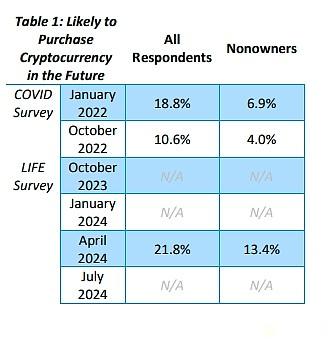
Source: Federal Reserve; Translated by Tao Zhu, Bitchain Vision
Since January 2022, the Consumer Finance Association (CFI) has collected information about cryptocurrency ownership from six different surveys; all six surveys asked about current holdings of cryptocurrencies, while three surveysAlso asked about the possibility of buying cryptocurrencies in the future.Comparing the survey results with cryptocurrency market performance, we observe a disconnect between market prices and holdings over the past two years.While we have seen a significant decline in holdings and buying interest during the 2022 cryptocurrency winter, recent market growth has not accompanied the increase in cryptocurrency holdings of the population we are surveying.
Using Bitcoin’s daily price as a representative of the overall value of the cryptocurrency market, we found that the cryptocurrency winter hit its lowest point at the end of 2022; between January and October 2023, the price rebounded at a relatively slow pace, and then in 2024March accelerated rapidly.Since then, they have remained at their highest point in five years or near their highest point in five years.
Starting in October 2023, CFI has collected quarterly LIFE survey data that shows how much cryptocurrency holds enable us to track holdings during market growth.These survey questions are similar to previous data collection issues in the 2022 CFI COVID-19 Consumer Survey.We found thatAlthough holdings dropped significantly during the cryptocurrency price decline in the cold winter, holdings did not grow at a corresponding rate during the recovery period.However, the recent price increase does seem to correspond to an increase in the proportion of respondents who may buy cryptocurrencies in the future.
Investigate differences in collection
The first two surveys that collected cryptocurrency ownership data were conducted as part of the COVID19 Consumer Survey conducted by CFI in January 2022 and October 2022; the last four surveys were part of the CFI Consumer Life Survey.There are two major differences between the two surveys, resulting in slightly different results; however, the weighted and comparison of responses to similar questions (except cryptocurrency questions) in the two surveys shows that the report of the two surveysThe results are comparable.
The results of the survey were collected by two different survey agencies.Both surveys are web-based, targeting 5,000 nationally representative survey results that are weighted by similar target distributions of major demographic categories.The same non-cryptocurrency issues in the two surveys yielded comparable results, and the relationship between the demographic groups of cryptocurrency holders at the two survey agencies is consistent.
Although the ownership rates of the two surveys are not completely comparable, each survey collected more than once.Two COVID-19 surveys covered the cryptocurrency winter, while four LIFE surveys covered the recent price recovery.Therefore, we can clearly compare ownership rate changes in each period.
Holding situation and price changes
To assess the relationship between cryptocurrency market conditions and holding rates and future purchase interest, we use the price of Bitcoin (BTC) as a proxy for the general cryptocurrency market.Figure 1 plots the daily closing price of Bitcoin between July 1, 2021 and July 9, 2024; the bar chart represents the cryptocurrency holding rate in each survey cited in this article.Looking at the bar charts for January 2022 and October 2022 in the chart, we see the changes pointed out in our previous reports;During the cryptocurrency winter, Bitcoin (and cryptocurrencies) prices fell rapidly and holdings fell.
Figure 1: Bitcoin closing price (left axis) and cryptocurrency holding rate (right axis)

The October 2023 survey shown in the chart is the first time that the LIFE survey has collected data on cryptocurrency holdings.Although the market has risen since the previous year, it has remained stable in the past six months, far below the value of cryptocurrencies before the winter; the holdings are basically the same as the previous year, at 17.1% (short considering the problem focus.There are differences).
Bitcoin prices began to rise after the October 2023 survey was conducted.By the time the LIFE survey was underway in January 2024, prices had risen by about 60%, recouping more than half of the value lost during the cryptocurrency during the cold winter.However, holdings fell slightly, down to 15.5%.
The market continues to rise, and by the time of the LIFE survey in April 2024, the price of Bitcoin has exceeded the value of cryptocurrencies before the cold winter.We continue to see little change in holding rates;Despite the significant increase in Bitcoin’s value in the past six months, only 16.1% of respondents listed themselves as cryptocurrency owners.This is not statistically different from the October 2023 holding rate.
Bitcoin’s price fluctuated between April and July 2024, but remained close to its recent highs; in the July 2024 LIFE survey, respondents reported thatBitcoin holdings dropped significantly to 14.7%.We see again that the performance of the market has not led to an increase in the public holding rate.
Future purchase interest
While the holding rate in the LIFE survey data has not increased with the price increase, we do see an increase in the proportion of respondents who may buy cryptocurrencies in the future.Similar questions were included in the 2022 COVID-19 survey and the April 2024 LIFE survey, and the results are reported in Table 1 .

Our previous report recorded overall interest in buying cryptocurrencies, including existing and unshelfers, declined during the cryptocurrency winter period, from 18.8% to 10.6% of all respondents.The next survey on the use of purchase intention issues was the LIFE survey in April 2024, when Bitcoin’s current price was at its highest point in three years.
At the time, 21.8% of respondents said they might buy cryptocurrencies in the future; while this did not translate into a higher holding rate for the group, the huge and rapid growth of the market seemed to increase its consumerAttractive.
Judging from the purchase intention of non-holders, this observation is clearer.In the 2022 survey, less than 7% of non-holders said they might buy cryptocurrencies in the future; however, in April 2024, that figure rose to 13.4%.
in conclusion
CFI survey data collected in 2022 shows thatCryptocurrency holders have changed due to the cryptocurrency winter; as market value drops, reported holdings and interest in buying cryptocurrencies are both declining.
Bitcoin’s price has risen sharply since the LIFE survey began collecting cryptocurrency holding data in October 2023; however,In four surveys, holdings fell slightly, although there is evidence that market performance has aroused higher interest in future purchases.
Additional studies on consumer-specific market entry and exit patterns may provide a clearer explanation of these observations.








